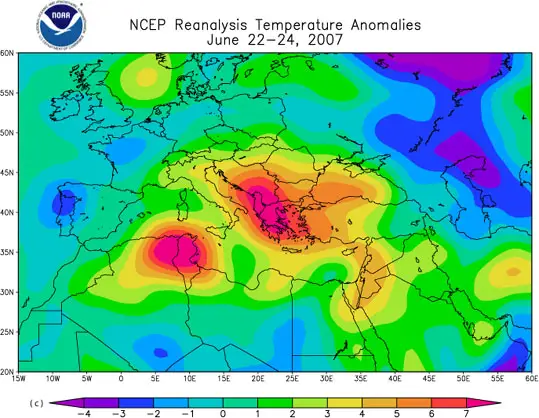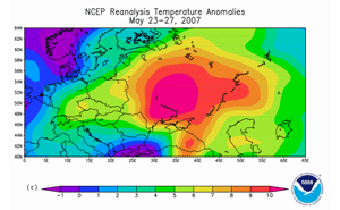An extreme heat wave was brought about on May 23rd–26th 2010 by the high pressure system over much of east-central North America. This system introduced high temperatures in large areas of the central, northern, and northeastern U.S. and Ontario and Quebec, Canada. In the U.S., hundreds of daily high maximum and high minimum temperature records were broken across Indiana, Illinois, Iowa, Wisconsin, Michigan, and Minnesota on the 24th and 25th. In Minneapolis, Minnesota, the temperature soared above 90°F (32°C) on the 24th, breaking the previous record of 88°F (31°C) set on this date back in 1875. On May 25th, the towns of Timmins and Kapuskasing in northwestern Ontario each experienced their warmest May temperature since records began in 1955. The temperature reached 94.3°F (34.6°C) in Timmins, which is 28.1°F (15.6°C) above normal for this time of year. By the 26th, the heat wave shifted eastward and hundreds of additional temperature records were broken, particularly across New York, Pennsylvania, New Hampshire, and Vermont, along with many other areas farther to south and southwest.
Prior to the onset of the Southwest Monsoon rains, northern India and Pakistan baked as a heat wave scorched the region near the end of May. The Pakistan Meteorological Department reported record temperatures for several days during the last week in May. A maximum temperature of 128.7°F (53.7°C) was recorded in Mohenjo-daro on May 26th. This was the warmest temperature ever recorded in Pakistan and possibly the fourth warmest temperature ever recorded anywhere in the world.
On the 27th May 2010, the maximum temperature in the city of Multan in Punjab Province reached 122°F (50°C), breaking the old record of 120°F (49°C) previously set in 1956. Temperatures were also well above normal in India—the highest in more than 50 years. The temperature reached 120°F (49°C) on May 26th in Jalgaon in Maharashtra state while India’s capital city, Delhi, topped out at 113°F (45°C. At least 18 people died in Pakistan and more than 260 perished in India due to the heat, according to local media reports. This was the first extreme heat wave to hit the Pakistani region since 1998.
An extreme heat wave in the U.S. Pacific Northwest during the last week in July 2009 led to numerous reports of record temperatures. High temperatures reportedly reached 92°F (33°C) in the typically cool region of Astoria, Oregon on July 28th, shattering the old daily record of 82°F (28°C). According to the National Weather Service, the high temperature at the Seattle-Tacoma International Airport on July 29th was 102°F (39°C), the highest temperature ever recorded at that locale during the 118-year period of record. With abnormally dry to moderate drought conditions already in place, the summer wildfire season is expected to be above normal, primarily due to lightning strikes, according to a U.S. Forest Service bioclimatologist.
At the beginning of July 2009, Britain continued to experience its warmest heat wave in three years, with a level three heat wave alert (the second highest alert) issued for the first time since 2006. Britain’s health service reported more than 300 calls for heat-related illnesses. The heat wave also affected Belgium, Germany, and France
In Australia, 2009 brought more of the same: extreme heat waves. Temperatures there remained above normal as an area of high pressure stalled over the Tasman Sea. In southern Australia, temperatures in Adelaide spiked to 45.5°C (114°F), making it the location’s hottest day in 70 years. By Friday 30 Jan 2009 Melburnians had endured three successive days of temperatures above 43 degrees Celsius for the first time in recorded history. Over the three days the mercury reached 45.1; 44.3 and 43.4 degrees. Organizers of the Australian Open tennis tournament enacted an “extreme heat policy” for the first time in history. Two deaths were reported in Melbourne.
An extreme heat wave affected parts of the U.S. from mid-July through early August 2008. In Denver, CO temperatures were above 32°C (90°F) for 24 consecutive days (as of August 5), breaking the previous record set in 1874 and 1901 with 18 consecutive days.
In California, Santa Ana winds brought warm air across parts of the state, prompting new daily maximum temperature records on the 12th April 2008. According to reports, El Cajon and Vista, California, suffered temperatures that rose to 34.4°C (94°F), surpassing the previous record of 31.7°C (89°F) set in 2000 and 30°C (86°F) set in 1994, respectively.
Regina, the capital of the Canadian prairie province of Saskatchewan, saw a new daily maximum temperature record on April 14 2008 when temperatures hit 28°C (82°F). The previous record was set in 1963 when temperatures soared to 26.7°C (80°F).
An extreme heat wave swept across southern areas of the state of California, 25 fatalities were attributed to the heat with temperatures soaring past the 40°C (104°F) mark. The excessive heat resulted in the declaration of an ‘electrical emergency’ by energy officials during the week of Sept 2 2007 and thus left about 55,000 people without electricity for two days
A heat wave affected Japan on August 16 2007 prompting temperatures to set a record high. In the city of Tajimi temperatures reached 40.9°C (105.6°F) breaking the previous record of 40.8°C (105.4°F) that was set on 1933. Seven fatalities were attributed to the heat.
24 July 2007, and an extreme heat wave is sweeping central and south-eastern Europe killing at least 25 people, with soaring temperatures sparking forest fires, and damaging crops. In Romania, an industry group estimated the agriculture sector had suffered more than £1billion in damages due to severe drought. The government has declared a state of disaster in 34 out of 42 counties so far and was paying farmers some compensation. Greece’s Fire Service reported 115 fires, and firefighters had struggled to contain a blaze at an old army base near Athens, where temperatures reached 41°C (105.8°F).
An extreme heat wave which commenced in late-May 2007 across areas of South Asia continued into early June. During the first half of June, a total of 37 fatalities were reported in India with 110 in Pakistan as a result of temperatures reaching 45°C to 52°C (113°F to 126°F). Minimum temperatures rarely fell below 30°C (86°F) in India providing little relief.
A heat wave affected areas across southeastern Europe during late June, prompting electricity demand to soar to record levels. About 40 deaths were attributed to high temperatures soaring past 40°C (104°F). Hot, dry weather experienced in southern Europe contributed to over 130 wild fires which have destroyed thousands of acres of land and killed two people (BBC News/Associated Press). Northern Africa suffered as well, with temperatures over 40°C (104°F) which contributed to the spread of several fires.

An extreme heat wave affected areas across western and central Russia during May 2007, breaking several temperature records. In Moscow, temperatures on the 28th reached 32.9°C (91.2°F), the highest temperature recorded in May since 1891 (31.8°C/89.2°F). This is the first time in 128 years that the Russian capital has suffered a sustained 30°C (86°F) or higher temperatures. This heat has prompted Russia’s energy administrator to restrict the use of non-residential energy for the first time in summer.

